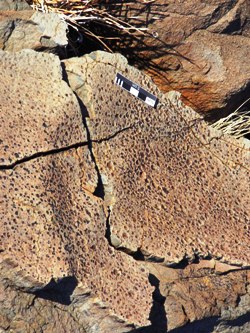
Precambrian showers constrain the density of ancient atmospheres, but pose problems for the 'faint Sun paradox'. Ted Nield reports
Geoscientist 22.05 June 2012
If the Sun 2.7 billion years ago was only 85% as hot as it is today, how come the Earth’s surface was so equable? Most proposed answers to this question involve enhanced greenhouse effect, which would also seem to presume a much more dense atmosphere. However, a new study of fossil raindrops suggests the density of the atmosphere at 2.7Ga was much the same as it is today
1.
The Sun is a ‘main sequence’ star, whose core density gradually increases with age – so raising the temperature at which its main fuel, hydrogen, fuses to form helium. A Sun with only 85% of modern radiance ought not to have been able to warm our planet to above the freezing point of water; yet, the existence of fossil raindrops – among other things – shows clearly that liquid water did then exist at surface. This problem is known to science as the ‘faint young Sun paradox’.
ALBEDO
Proposed solutions to the paradox tend to fall into one of two types – the sort that propose increase greenhouse effect on the one hand, and the sort that suggests the Earth’s albedo may once have been lower. Equable surface temperatures at this time can be explained by invoking high CO
2 concentrations, but carbon isotope work on fossil soils suggests that CO
2 alone cannot do the trick, requiring nitrogen levels at twice today’s levels as well.
The big problem with these speculations about atmosphere chemistry is that no constraining data exist either on air density at ground level, nor prevailing barometric pressure. Now, a paper in Nature by Sanjay Som and colleagues has attempted to shed light on this problem by comparing fossil raindrops from tuffs of the Ventersdorp Supergroup in South Africa with rain-induced structures produced in the laboratory by water falling on volcanic ash.
The two parameters of importance are raindrop size and terminal velocity. Raindrops form when the initial blob of condensing water reaches a speed at which it flattens and then breaks up. The raindrops’ size is limited to a maximum that is independent of air density; whereas the droplet terminal velocity varies as the inverse of the square root of air density.
So, because the density controls terminal velocity, estimates of this can be converted into density, which in turn can be used to, if not define, at least place limits on likely prevailing barometric pressure. Any difference between velocities inferred from ancient raindrops and those produced in the lab may therefore be telling us about some alteration in climate density.
After comparing the geometry of raindrop impact structures ancient and modern, the authors conclude that atmospheric density at 2.7Ga was probably somewhere between 50% and 105% of today’s values. If this is true, it means that very high concentrations of carbon dioxide and nitrogen may not be invoked to explain the Faint Young Sun Paradox. It therefore seems likely that one or more highly efficient greenhouse gases, such as methane, ethane and carbonyl sulphide, may have been responsible.
Reference
- Air density 2.7 billion years ago limited to less than twice modern levels by fossil raindrop imprints, by Sanjay M. Som, David C. Catling, Jelte P. Harnmeijer, Peter M. Polivka & Roger Buick. Nature 484,359–362 April 19 2012 doi:10.1038/nature10890